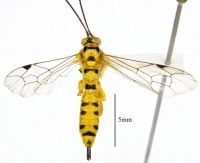ICHNEUMONIDAE: : Xanthopimpla Saussure 1892
Diagnosis:
Characteristics of Xanthopimpla include: 1. Body size <10mm; 2. Position of spiracle on T1 at, close to, or before centre; 3. Shape of aerolet in forewing triangulate or pentagonal, but the areolet is open; 4. Colour of face is yellow; 5. Metasoma compressed dorsal-ventrally; 6. Size of ocelli small; 7. Length of antennae as long, or longer than body; 8. Length of ovipositor short, not longer than body; 9. Wings present; 10. Colour of wings hyaline (clear); 11. Sternaulus (on mesopleuron) absent; 12. Shape of face in lateral view flat or only weakly bulging; 13. Sternite on T1 (viewed laterally) not extending past spiracle; 14. Shape of T1 (viewed laterally) evenly curved; 15. Number of teeth in mandibles 2; 16. Metasoma yellow with black spots; 17. Length of T1 less than T2 or subequal in length; 18. Sculpture on mesoscutum smooth, very polished; 19. Width of T1 (viewed dorsally) of uniform width (slightly widening posteriorly); 20. Glymma on T1 present, (deep pit); 21. Sculpture on metasoma punctured, striated; 22. Propodeum reaching past coxal insertion, but not reaching halfway along metacoxae.Similarity to Other Taxa
Xanthopimpla rhopaloceros is very easy to identify. It is the only yellow ichenumonid in New Zealand, hence its common name, the Yellowbanded leafroller parasite.Distribution in NZ
North Island: ND, AK, BP, HB, TK, TO, WI, WN, WO. South Island: NN, MC.
Species in NZ
One biological control agent, Xanthopimpla rhopaloceros Krieger 1914.Biology & hosts
Xanthopimpla is a very large genus from the tropics, most species of which occur in South East Asia (Gauld 1984). The majority of Xanthopimpla species occur in tropical forests at various altitudes from coastal mangrove swamps to montane forests. Several are commonly collected in agricultural areas where they parasitise a variety of Lepidoptera pests (Gauld 1984).Xanthopimpla rhopaloceros was introduced into New Zealand in the 1960-70s to control the light brown apple moth Epiphyas postvittana (Lepidoptera: Tortricidae), but its impact is considered minimal (Cameron et al 1989; Munro 1998). It is widespread in the North Island, but not common.
Overseas, Xanthopimpla rhopaloceros has also been recorded from Uraba lugens (Nolidae); Hierodoris atychioides (Oecophoridae); Liothula omnivora (Psychidae); and Merophyas divulsana (Tortricidae) (Yu et al. 2005).
Sources of information
Cameron PJ, Hill RL, Bain J & Thomas WP. 1989. A Review of Biological Control of Invertebrate Pests and Weeds in New Zealand 1874-1987. Technical Communication No 10. CAB International Institute of Biological Control. DSIR Entomology Division. 424 p.Gauld ID. 1984. An Introduction to the Ichneumonidae of Australia. London, British Museum (Natural History). 413 p.
Munro VMW. 1998. A record of the releases and recoveries of the Australian parasitoids Xanthopimpla rhopaloceros Krieger (Hymenoptera: Ichneumonidae) and Trigonospila brevifacies Hardy (Diptera: Tachinidae) introduced into New Zealand for leafroller control. New Zealand Entomologist 21: 81-91.
Yu DS, van Achterburg K, Horstmann K. 2005. World Ichneumonoidea 2004. Taxonomy, Biology, Morphology and Distribution. CD/DVD. Taxapad. Vancouver, Canada.
Citation
Ward DF & Schnitzler FR. 2013. Ichneumonidae of New Zealand. Genus Xanthopimpla http://ichneumonidae.landcareresearch.co.nzAccessed: 27 April 2025


